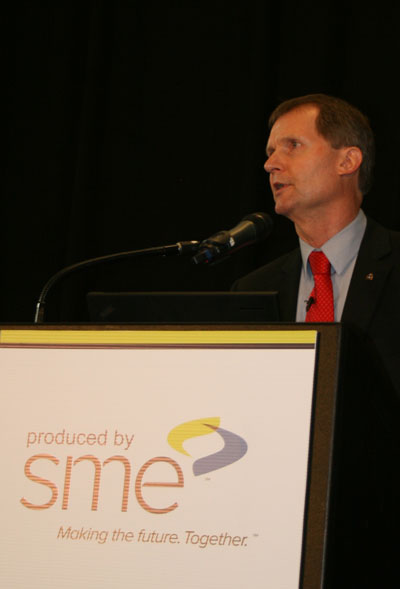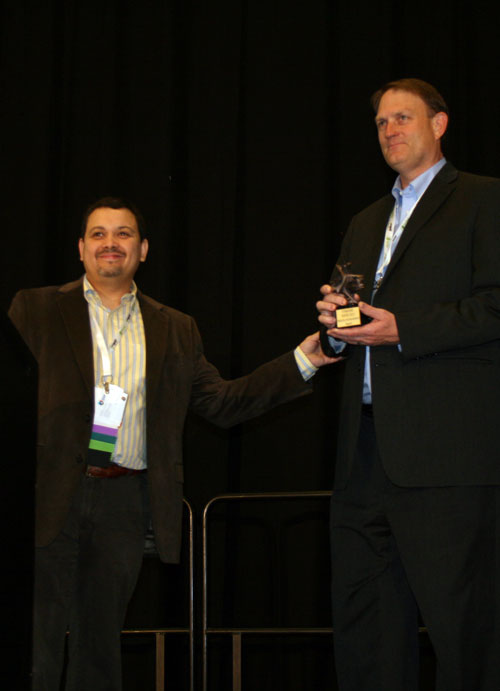Rapid 2013 Day 2: The State of the Additive Manufacturing Industry
Latest News
June 12, 2013
Terry Wohlers of the consulting and research firm, Wohlers Associates, kicked off the second day of the RAPID 2013 Conference and Exhibition in Pittsburgh this morning (read about the first day’s keynote here). As he has in years past, Wohlers presented findings from his annual Wohlers Report, which tracks the additive manufacturing industry.
Wohlers took a global perspective of the technology and provided perspective on where the industry might go in the future. But first, he looked back to 1988 when 3D Systems first commercialized additive manufacturing.
“It hasn’t been until relatively recently that we’ve applied additive manufcaturing to making final products,” he said. “We’re just getting started, really. We have so much to learn about this process.”
While it was learning last year, the industry grew 28.6%, according to Wohlers, who said the media attention surrounding 3D printing grew by 100%. “It’s creating the illusion that this is brand-new technology” and has advanced rapidly overnight, he said. “That’s not the case. We’ve seen steady advancement over the past 25 years.”
Industrial Unit sales of machines that sell for $5,000 or more grew by 19.3%, while low-cost personal 3D printers that sell for $200-$5,000 sales have slowed. Wohlers said personal 3D printer sales grew, on average, by 346% since 2007. Last year personal 3D printer sales grew by 46.6%, accounting for 6.5% of total system sales revenues in 2012.
“I really think that at the current level of quality of these personal 3D printers, the low-hanging fruit has been picked,” Wohers said. He added that the quality will need to improve if the segment will see double-digit growth again.
Going Global
Turning toward the global outlook for additive manufacturing, Wohlers said 38% of the industrial systems sold worldwide up through last year are being used in the US, followed by Japan, Germany and China that are all at less than 10%.Part of that strong base comes from companies like Honeywell and GE Aviation driving AM, especially with their use of the technology in aerospace. Wohlers says GE Innovation, for example, plans to spend $3.5 billion over the next five years on additive manufacturing. The automotive industry is also paying attention to AM, though only three people raised their hands when Wohlers asked who in the audience was from the auto industry.
“We need to light a fire under these companies,” he said. “I would encourage auto companies to re-engage, even though the volumes aren’t like medical and aerospace,” there are many low-volume applications, especially in luxury sports cars and tooling needs.
Other companies you might not expect, such as Nike and New Balance have used AM for years, and have begun commercializing the 3D printing of show soles for the first time, according to Wohlers. Amazon also has a new section dedicated to 3D printing.
When President Obama said: “3D printing has the potential to revolutionize the way we make almost everything” in the State of the Union address, it had repurcussions beyond our borders.
Wohlers, just back from the 2013 World 3D Printing Technology Industry Conference in China, said that statement focused galvanized countries’ support for AM. He said China’s central government is funding AM to the tune of $245 million for a 7-year pilot program.
“One strategy the country may pursue is to buy its way in,” Wohlers said, to meet its goal to become the No. 1 country in the AM industry in the next three years.
Wohlers noted other countries’ AM activity:
- Japan has a long history of AM, even to the point of developing stereolithography around the same time as 3D Systems in 1988.
- Australia, which has the most titanium of any region in the world, is looking at 3D printing research that would allow it to use the material in AM.
- In South Africa, they are building a large-format powderbed fusion system with a 5kw laser that they say could be 10x faster than anything else out there.
- Germany has been focusing on large powderbed fusion systems from the likes of Concept Laser and SLM Solutions.
- Canada has woke up to AM in the last few years, perhaps because of its large aerospace industry.
“We’re going to see a whole new way of thinking and new business models,” Wohlers said. “However, we’ve lost some of our edge” as other countries now have many more large-scale AM system manufacturers than the U.S. does.
Wohlers noted the following challenges to the AM industry:
- Tools for AM are not fully integrated into popular CAD software products, but are only available as add-ons.
- Getting to the break-even point on whether conventional products are a good fit for AM, and companies spending the time to make that determination.
- Economies of scale are still a factor in AM.
“I think children will be a big market, as for parents ...” Wohlers said. “We’ll have professionals shipping parts to consumers, rather than consumers making their own. I could be wrong, but that’s my opinion. We will, however, have much more variety because we can make products that weren’t practical before.”
Awards Presented
In related news, SME presented the following awards for this year’s show:- Best in Show: Concept Laser
- Innovation: NNMC for its Multi Process Prototyping Machine
- Best Paper: VAST AUAV by Michael Stern and Eli Cohen
- Industry Achievement: Scott Crump, Stratasys
- DDM Design Competition Winners: UMASS Lowell for Custom Post Reconstructive ACL Surgery, Knee Brace.
Subscribe to our FREE magazine, FREE email newsletters or both!
Latest News
About the Author
Jamie Gooch is the former editorial director of Digital Engineering.
Follow DE







